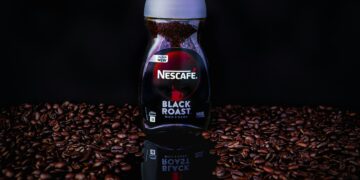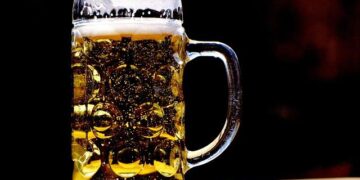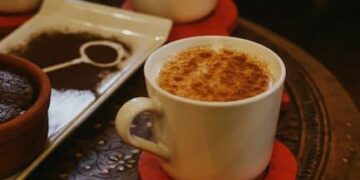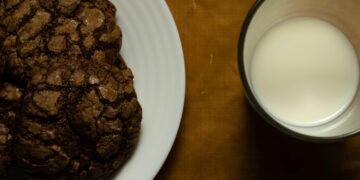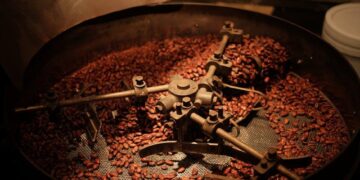Table of Contents
As a food scientist, my relationship with coffee has always been a blend of professional admiration and personal affection.
I understood its intricate chemistry, the miraculous dance of compounds that produces its rich aroma and the cognitive spark it provides.1
For years, my morning ritual was built around a steaming mug of hot-brewed coffee.
It was a sensory anchor and a productivity tool.
But over time, a troubling paradox emerged.
The very beverage I relied on to start my day began to turn on me.
The subtle warmth in my chest after the first few sips slowly morphed into a persistent, low-grade heartburn that would linger for hours.3
The complex, bitter notes I once savored now seemed harsh, a flavor I found myself instinctively masking with increasing amounts of cream and sugar.4
Worse, the clean energy boost I sought was replaced by a jagged, jittery spike followed by an inevitable afternoon crash.
My body was sending clear signals of distress, creating a frustrating conflict between my professional knowledge of coffee’s benefits and my personal experience of its drawbacks.
This disconnect became my catalyst.
I decided to stop being a passive victim of my morning cup and instead apply my scientific training to my own problem.
My investigation turned to cold brew, a method surrounded by a confusing fog of marketing hype and anecdotal claims.5
Was it truly “less acidic”? Was it healthier? Or was it just a trend? I embarked on a personal and professional quest to deconstruct the chemistry of cold brew, not just to find a better coffee, but to find a better relationship with coffee itself.
Part I: The Anatomy of a Problem: Why My Hot Coffee Turned Against Me
To understand the solution, I first had to precisely define the problem.
My journey began by re-examining the familiar process of hot brewing, but this time through a more critical lens.
I came to think of it as a form of “high-heat searing.” Like searing a steak on a blazing-hot skillet, hot brewing is a fast, intense, and fundamentally aggressive chemical process.
The near-boiling water acts as a powerful solvent, but its brute force doesn’t just extract desirable flavors; it violently alters and degrades many of the delicate compounds locked within the coffee grounds.7
This chemical aggression manifests in several ways that directly explained my discomfort.
First, the intense heat is indiscriminate, pulling out a wide spectrum of compounds, including the ones responsible for harsh bitterness, like phenols.7
More importantly, heat accelerates the degradation of a key group of compounds called chlorogenic acids (CGAs).
In hot water, these CGAs rapidly break down into quinic and caffeic acids, which are primary contributors to the sharp, “bright,” and often irritating acidity that many people (including me) experience as heartburn.7
This aggressive extraction chemistry created a cascade of negative nutritional consequences.
The resulting brew was often so bitter and acidic that I felt compelled to “fix” it.
This led me straight into the sugar trap.
My daily cup, which should have been a nearly zero-calorie, antioxidant-rich beverage, became a vessel for sugar and high-fat creamers, sabotaging my health goals with empty calories.3
It was a vicious cycle.
The brewing method itself created a harsh flavor profile.
To make it palatable, I added ingredients that negated coffee’s inherent health benefits and introduced their own problems, from potential weight gain to blood sugar dysregulation.
The problem wasn’t just the coffee; it was the chain of nutritional compromises that the hot brewing method encouraged.
My digestive system was simply the first to sound the alarm.11
Part II: The Epiphany: Discovering the “Low-and-Slow” Extraction Paradigm
My breakthrough came not in a lab, but at a small, independent coffee shop.
On a whim, I ordered a black cold brew.
The first sip was a revelation.
It was smooth, rich, and possessed a natural, almost chocolatey sweetness.
There was none of the biting acidity or harsh bitterness I had come to associate with black coffee.
It was delicious on its own, no “fixing” required.
This sensory experience sparked my scientific epiphany.
I realized that cold brew operated on an entirely different chemical philosophy.
If hot brew was “high-heat searing,” then cold brew was the “sous-vide” of coffee. Like the culinary technique of cooking food slowly in a temperature-controlled water bath, cold brew replaces the brute force of heat with the gentle, persistent influence of time.14
By steeping coffee grounds in cold or room-temperature water for an extended period—typically 12 to 24 hours—the extraction process becomes far more selective.17
It doesn’t shock and fracture delicate molecules.
Instead, it coaxes out flavor and caffeine slowly and gently.
This methodical process preserves many of the desirable, volatile aromatic compounds while leaving behind a significant portion of the bitter-tasting acids and oils that are only soluble at high temperatures.7
This fundamental shift from a heat-based to a time-based extraction was the key.
It was a quieter, more patient way of making coffee, and it promised to solve the very problems that had plagued my morning ritual.
Part III: The Cold Brew Blueprint: A Complete Nutritional & Chemical Profile
Armed with this new paradigm, I dove into the data.
I needed to quantify the differences and build a complete, evidence-based profile of cold brew.
What follows is the blueprint I assembled, moving beyond marketing claims to the scientific facts.
The Foundational Nutrients: More Than Just Brown Water
At its core, black cold brew is a minimalist beverage.
An analysis of various commercial brands shows that a standard 12 oz (360 ml) serving is exceptionally low in calories, typically ranging from 10 to 15.18
It contains virtually no fat, less than one gram of protein, and only 2 to 3 grams of carbohydrates, none of which are from sugar.18
However, “low-calorie” does not mean “devoid of nutrients.” The most significant micronutrient present is potassium.
A single 12 oz serving can contain as much as 290 mg of potassium, which accounts for about 6% of the recommended Daily Value.18
This is a noteworthy contribution, as potassium is a vital electrolyte that plays a critical role in maintaining proper fluid balance, regulating blood pressure, and supporting muscle and nerve function.22
| Nutrient | Typical Amount (per 12 oz / 360 ml) | % Daily Value (DV) | Significance |
| Calories | 10-15 | N/A | A very low-calorie base, making it suitable for most dietary plans. |
| Total Fat | 0 g | 0% | Contains no fat, making it a lean beverage choice. |
| Total Carbohydrates | 2-3 g | ~1% | Minimal carbohydrate content. |
| Total Sugars | 0 g | N/A | Contains no natural or added sugars. |
| Protein | < 1 g | ~1% | Not a significant source of protein. |
| Sodium | 0-10 mg | < 1% | Very low in sodium. |
| Potassium | 180-290 mg | 4-6% | A surprising and beneficial source of this essential electrolyte, which supports cardiovascular health and nerve function.18 |
The Caffeine Equation: Debunking the “Stronger” Myth
One of the most persistent myths about cold brew is that it is always higher in caffeine.
The reality is more nuanced and centers on a key distinction: concentrate versus ready-to-drink.
Cold brew is often prepared as a concentrate, using a high ratio of coffee grounds to water (from 1:4 to 1:8) over a long steeping period.14
This undiluted concentrate is, indeed, very dense in caffeine.
However, this concentrate is almost always diluted with water, ice, or milk before it is served.
The final, ready-to-drink beverage typically has a caffeine content that is comparable to, or slightly higher than, a standard hot-brewed coffee.
A common figure for a 16 oz serving of cold brew is around 200 mg of caffeine, whereas a similar-sized hot coffee might contain 140-165 mg.14
The final caffeine payload in your cup is not fixed; it is a variable you can control based on several factors:
- Coffee-to-Water Ratio: The more coffee grounds used relative to water, the stronger the final concentrate will be.14
- Bean Type: Robusta beans contain nearly twice as much caffeine as the more common Arabica beans.14
- Steeping Time: While the majority of caffeine is extracted in the first several hours, longer steeping times can modestly increase the final concentration.14
The Acidity Question, Settled: pH vs. Titratable Acidity
Here lies the most misunderstood aspect of cold brew, and the key to its gentle nature.
Many consumers, and even some marketing materials, claim cold brew is “less acidic,” yet scientific studies reveal a confusing paradox: the pH level of cold brew and hot brew are often nearly identical, both typically measuring between 4.85 and 5.13 on the pH scale.11
Since a lower pH indicates higher acidity, this finding seems to debunk the entire claim.
However, pH only tells part of the story.
My investigation revealed that the crucial difference lies in a measurement called Total Titratable Acidity (TTA).
In simple terms, while pH measures the strength of the acids present, TTA measures the total quantity of those acids.
And here, the science is unequivocal: hot-brewed coffee has a significantly higher TTA than cold brew made from the same beans.6
The aggressive heat of hot water is simply more effective at extracting a larger volume of various acidic compounds from the coffee grounds.7
This single chemical difference—lower Total Titratable Acidity—is the domino that triggers a cascade of benefits:
- Improved Flavor: With a lower concentration of acidic compounds, the resulting brew is sensorially less bitter, less sour, and smoother, with more prominent floral and sweet notes.5
- Reduced Need for Additives: Because the flavor is naturally smoother and sweeter, the behavioral impulse to mask harshness with sugar and cream is dramatically reduced.3
- Better Digestive Tolerance: The lower load of total acids makes the beverage gentler on the digestive system, reducing the likelihood of irritation for those with acid reflux or sensitive stomachs.3
- Enhanced Dental Health: A lower TTA also means the liquid is less erosive to tooth enamel over time.34
The Antioxidant Reality: An Honest Broker’s Report
In the spirit of scientific integrity, it is crucial to present the complete picture.
While cold brew excels in having a lower TTA, research consistently shows that hot brewing is a more efficient method for extracting certain beneficial compounds, particularly a class of antioxidants known as caffeoylquinic acids (CQAs).6
The heat helps to release more of these molecules, meaning that on a cup-for-cup basis, hot coffee often demonstrates higher total antioxidant activity.6
However, this finding requires context.
First, cold brew is still a rich source of antioxidants; it simply contains a different profile and concentration of them, and longer steeping times can increase their extraction.38
Second, for most people consuming a varied and balanced diet, the marginal difference in antioxidant intake from one type of coffee versus another is unlikely to have a significant impact on overall health.6
The choice, therefore, is not about finding a universally “superior” beverage but about understanding the trade-offs.
If your sole priority is to maximize the intake of CQAs and your digestive system is resilient, hot brew is an excellent choice.
If, however, your goals include digestive comfort, dental health, and avoiding the sugar trap, the unique chemical profile of cold brew offers a clear and scientifically supported advantage.
Part IV: The Solution in Practice: How to Leverage Cold Brew for Your Body
Understanding the science is the first step.
The next is applying that knowledge to build a healthier coffee habit.
The “low-and-slow” paradigm offers practical solutions for everyday wellness and athletic performance.
A Prescription for the Sensitive Stomach & Smile
For the millions of people who, like me, experience digestive discomfort from coffee, the science behind TTA provides a clear verdict.
Cold brew is a demonstrably gentler option.
Its lower concentration of extracted acids is less likely to irritate the stomach lining, making it a suitable choice for individuals with GERD, acid reflux, or general gastric sensitivity.3
This same principle applies to dental health.
The acids in beverages are a primary cause of enamel erosion, which can lead to sensitivity and an increased risk of cavities.
With a lower total acid load, cold brew is less chemically aggressive toward your teeth than its hot-brewed counterpart.34
While any coffee can cause staining, a less acidic environment may make enamel less susceptible to it over the long term.40
Building a Healthier Cup: Escaping the Additive Trap
The most profound health benefit of cold brew may not be chemical, but behavioral.
Its naturally smooth, low-bitterness profile breaks the vicious cycle of needing to add sugar and cream to make coffee palatable.3
This was the key to my own transformation, allowing me to enjoy coffee black for the first time in years.
When additions are desired, understanding their nutritional cost is critical.
A single pump of flavored syrup from a coffee shop can contain 20-25 calories and 5-6 grams of sugar.41
Since many popular drinks contain four to six pumps, a single beverage can easily deliver more than the American Heart Association’s entire recommended daily limit for added sugar.42
Some specialty drinks can contain over 100 grams of sugar.44
Choosing your additions wisely transforms your coffee from a potential liability into a healthy asset.
| Nutrient | Black Cold Brew (16 oz) | + 4 oz 2% Milk | + 4 oz Oat Milk | + 4 oz Unsweetened Almond Milk | + 4 pumps Vanilla Syrup |
| Calories | ~20 | ~85 | ~95 | ~35 | ~120 |
| Total Fat (g) | 0 | 2.5 | 3.5 | 1.5 | 0 |
| Total Carbs (g) | 4 | 10 | 15 | 4.5 | 24 |
| Added Sugar (g) | 0 | 0 | 0 | 0 | 24 |
| Protein (g) | < 1 | 5 | 2 | 0.5 | 0 |
Note: Values are approximate and can vary significantly by brand and preparation.
Milk nutrition data is averaged from sources.45
Syrup data is based on an average of 25 calories and 6g sugar per pump.41
Fueling Performance: The Athlete’s Edge
For athletes, caffeine is a well-documented ergogenic aid, proven to enhance endurance, increase strength output, and sharpen focus.47
Cold brew offers several unique advantages in this context.
First, it allows an athlete to consume a potent dose of caffeine without the bitterness that might tempt them to add performance-hindering sugar.49
More importantly, its lower TTA profile makes it a much safer pre-workout fuel.
Gastrointestinal distress is a common race-day disaster for many athletes, and the lower acidity of cold brew significantly reduces the risk of the heartburn or stomach upset that could compromise performance.49
Furthermore, research indicates that consuming caffeine alongside carbohydrates after a workout can accelerate muscle glycogen replenishment by as much as 66%, speeding up recovery and preparing the body for the next training session.51
A post-workout cold brew mixed with a source of protein and carbohydrates can be an effective and refreshing recovery tool.
Conclusion: My New Ritual—A Verdict from the Lab and the Kitchen
My journey began with a personal problem: a beloved daily ritual that was causing me physical discomfort.
By applying the principles of food science, I deconstructed that problem and discovered a solution rooted not in hype, but in chemistry.
The “high-heat searing” of hot brewing, with its aggressive extraction of acids, was the source of my issues.
The “low-and-slow” paradigm of cold brew, which uses time instead of heat, offered a gentler, more selective alternative.
Cold brew is not a magic bullet or a universal cure-all.
It represents a series of trade-offs.
While it may offer slightly less antioxidant activity than a meticulously prepared hot brew, its unique chemical profile provides tangible, evidence-based solutions for some of coffee’s most common problems: digestive irritation, the temptation to add excessive sugar, and the risk of GI distress for athletes.
Ultimately, my investigation did not crown a “winner” in the coffee wars.
Instead, it gave me a deeper understanding.
It replaced confusion with clarity, allowing me to move beyond marketing claims and build a new coffee ritual that is both enjoyable and genuinely supportive of my health.
My hope is that this blueprint—a synthesis of lab findings and lived experience—can empower you to do the same, transforming your daily cup from a habit into a conscious, informed, and truly beneficial part of your life.
Works cited
- Effects of Coffee and Its Components on the Gastrointestinal Tract and the Brain–Gut Axis, accessed August 3, 2025, https://pmc.ncbi.nlm.nih.gov/articles/PMC7824117/
- 9 Impressive Benefits of Cold Brew Coffee (Plus How to Make It), accessed August 3, 2025, https://www.healthline.com/nutrition/cold-brew-coffee-benefits
- The Benefits Of Cold-brewing Your Coffee | Piedmont Healthcare, accessed August 3, 2025, https://www.piedmont.org/living-real-change/the-benefits-of-cold-brewing-your-coffee
- Does anyone feel better drinking cold brew than regular coffee? – Reddit, accessed August 3, 2025, https://www.reddit.com/r/Coffee/comments/kimg64/does_anyone_feel_better_drinking_cold_brew_than/
- Worth the Wait: How Cold Brew Differs from Chilled Hot Brew | 25, Issue 22, accessed August 3, 2025, https://sca.coffee/sca-news/25/issue-22/how-cold-brew-differs-from-chilled-hot-brew
- Hot coffee delivers more antioxidant benefits than cold brew, research finds, accessed August 3, 2025, https://news.medill.northwestern.edu/chicago/hot-coffee-delivers-more-antioxidant-benefits-than-cold-brew-research-finds/
- The Chemistry of Cold Brew Coffee vs. Hot Brewed Coffee – Espresso Outlet, accessed August 3, 2025, https://espressooutlet.com/blogs/news/the-chemistry-of-cold-brew-coffee-vs-hot-brewed-coffee
- Is Cold Brew Less Acidic Than Traditional Hot Coffee? – Primula Products, accessed August 3, 2025, https://primulaproducts.com/a/blog/is-cold-brew-less-acidic
- Choosing A Healthy Cold Brew – Wandering Bear Coffee, accessed August 3, 2025, https://wanderingbearcoffee.com/blogs/articles/cold-brew-nutrition-facts
- Cold brew coffee as healthy as the hot kind | Harvard T.H. Chan School of Public Health, accessed August 3, 2025, https://hsph.harvard.edu/news/cold-brew-coffee-as-healthy-as-the-hot-kind/
- Which is less acidic : r/Coffee – Reddit, accessed August 3, 2025, https://www.reddit.com/r/Coffee/comments/hwl8as/which_is_less_acidic/
- Is cold brew really better for acid reflux? : r/Coffee – Reddit, accessed August 3, 2025, https://www.reddit.com/r/Coffee/comments/f5tuua/is_cold_brew_really_better_for_acid_reflux/
- Sensitive Stomach? Here’s How to Find Low Acid Coffee, accessed August 3, 2025, https://peakstatecoffee.com/blogs/peak-state/sensitive-stomach-six-factors-of-acidity-in-coffee
- Does Cold Brew Have More Caffeine? The Caffeine Content …, accessed August 3, 2025, https://www.cooperscoffeeco.com/does-cold-brew-have-more-caffeine-the-caffeine-content-dilemma-unfolded/
- Cold Brew vs Hot Brew: Everything You Need to Know! – Uno Casa, accessed August 3, 2025, https://unocasa.com/blogs/tips/cold-brew-vs-hot-brew
- Cold Brew vs. Iced Coffee: What’s the Difference?, accessed August 3, 2025, https://fostercoffee.co/blogs/news/cold-brew-vs-iced-coffee-whats-the-difference
- Cold Brew vs Iced Coffee: Differences, Benefits, and How to Make Them – GEVI, accessed August 3, 2025, https://gevi.com/blogs/coffee-knowledge/cold-brew-vs-iced-coffee-guide
- SToK Cold Brew Coffee, Unsweetened Black 48oz Wholesale …, accessed August 3, 2025, https://www.danoneawayfromhome.com/food-service-products/stok-cold-brew-coffee-unsweetened-black-48oz/
- STōK Unsweetened Black Cold Brew Coffee, accessed August 3, 2025, https://www.stokbrew.com/cold-brew/cold-brew-coffee/unsweetened-cold-brew-coffee-48oz
- CALIFIA FARMS Unsweetened Medium Roast Pure Cold Brew Black Coffee, 48 fl oz, accessed August 3, 2025, https://www.fairwaymarket.com/product/califia-farms-unsweetened-medium-roast-pure-cold-brew-black-coffee-48-fl-oz-id-00813636020645
- Calories in Unsweetened Black Cold Brew Coffee by Stok and Nutrition Facts – MyNetDiary, accessed August 3, 2025, https://www.mynetdiary.com/food/calories-in-unsweetened-black-cold-brew-coffee-by-stok-fl-oz-25213182-0.html
- The Synergy of Ions: How Mineral Combinations Shape Coffee’s Flavour P – Apax Lab, accessed August 3, 2025, https://apaxlab.com/blogs/news/the-synergy-of-ions-how-mineral-combinations-shape-coffees-flavour-profile
- Boost Your Potassium Intake with Coffee, accessed August 3, 2025, https://generalwarfieldscoffee.com/blogs/our-blog/boost-your-potassium-intake-with-coffee
- 5 Things to Know About Cold Brew Coffee | Kaldi’s Coffee Blog, accessed August 3, 2025, https://kaldiscoffee.com/blogs/news/5-things-you-should-know-about-cold-brew
- Differences Between Cold Brew and Iced Coffee – Honeylus, accessed August 3, 2025, https://www.honeylus.com/differences-between-cold-brew-and-iced-coffee/
- Cold Brew vs. Iced Coffee: What’s the Difference? – GoodRx, accessed August 3, 2025, https://www.goodrx.com/well-being/diet-nutrition/cold-brew-vs-iced-coffee
- Caffeine Content: Espresso vs. Drip vs. Cold Brew, accessed August 3, 2025, https://fifty5rivers.com/journals/caffeine/caffeine-amounts-by-brewed-coffees/
- How Much Caffeine is in Cold Brew Coffee? | STōK, accessed August 3, 2025, https://www.stokbrew.com/what-is-cold-brew/how-much-caffeine-is-in-cold-brew/
- Acidity and Antioxidant Activity of Cold Brew Coffee – PubMed, accessed August 3, 2025, https://pubmed.ncbi.nlm.nih.gov/30375458/
- Hot Brew Coffee Has Higher Antioxidant Levels Than Cold Brew – Thomas Jefferson University, accessed August 3, 2025, https://www.jefferson.edu/news/2019/04/hot-brew-coffee-has-higher-antioxidant-levels-than-cold-brew.html
- Comparative Profiling of Hot and Cold Brew Coffee Flavor Using Chromatographic and Sensory Approaches – PMC, accessed August 3, 2025, https://pmc.ncbi.nlm.nih.gov/articles/PMC9562860/
- Understanding Cold Brew – Coffee Science Foundation, accessed August 3, 2025, https://coffeescience.foundation/understanding-cold-brew
- The Science Behind Cold Brew: Why It’s Easier on Your Stomach – Blackbird Beverages, accessed August 3, 2025, https://www.blackbirdbeverages.com/the-science-behind-cold-brew-why-its-easier-on-your-stomach
- Why Your Dentist Might Prefer Cold Brew: Coffee & Dental Health, accessed August 3, 2025, https://aloradentalclinic.com/why-your-dentist-recommends-cold-brew/
- How Does Coffee Affect Your Dental Health?, accessed August 3, 2025, https://fittosmile.com/how-does-coffee-affect-your-dental-health/
- Is Hot Coffee Better For You Than Cold Brew? – Sprudge, accessed August 3, 2025, https://sprudge.com/is-hot-coffee-better-for-you-than-cold-brew-138025.html
- Hot brew coffee has higher levels of antioxidants than cold brew : r/science – Reddit, accessed August 3, 2025, https://www.reddit.com/r/science/comments/9twy2l/hot_brew_coffee_has_higher_levels_of_antioxidants/
- Variables Affecting the Extraction of Antioxidants in Cold and Hot …, accessed August 3, 2025, https://pmc.ncbi.nlm.nih.gov/articles/PMC10812495/
- The 101 on Coffee Acidity – RISE Brewing Co., accessed August 3, 2025, https://risebrewingco.com/blogs/on-the-rise/the-101-on-coffee-acidity
- Dental Staining Associated with Various Types of Coffee, accessed August 3, 2025, https://www.jrmds.in/articles/dental-staining-associated-with-various-types-of-coffee-94752.html
- Coffee Health and Nutrition: Sweetening & Flavoring Solutions – La …, accessed August 3, 2025, https://www.lavitadolcecafe.com/coffee-nutrition-flavoring/
- Is What’s Hiding In Your Iced Coffee Bad for Your Health? – Houston Methodist, accessed August 3, 2025, https://www.houstonmethodist.org/blog/articles/2022/may/is-whats-hiding-in-your-iced-coffee-bad-for-your-health/
- How Much Sugar Is In My Starbucks? – Inspira Health Network, accessed August 3, 2025, https://www.inspirahealthnetwork.org/news/healthy-living/how-much-sugar-my-starbucks
- Every Dunkin’ Drink—Ranked by Sugar Content – Eat This Not That, accessed August 3, 2025, https://www.eatthis.com/dunkin-drinks-ranked-by-sugar/
- Which milk is best? Almond, hemp, oat, soy, or cow’s milk, accessed August 3, 2025, https://www.medicalnewstoday.com/articles/325425
- Oat Milk vs. Almond Milk: Which Is Better? – Healthline, accessed August 3, 2025, https://www.healthline.com/nutrition/oat-milk-vs-almond-milk
- Nitro Cold Brew in Athletics – Trident Coffee, accessed August 3, 2025, https://tridentcoffee.com/blogs/news/nitro-cold-brew-in-athletics
- Connecting Two Worlds: Cold Brew and Sports – 25GRAMS, accessed August 3, 2025, https://25grams.coffee/en/blogs/25grams-blog/cold-brew-the-go-to-drink-for-athletes
- Caffeine-Packed Cold Brew: The Latest Sports Nutrition Trend – Triathlete, accessed August 3, 2025, https://www.triathlete.com/nutrition/race-fueling/caffeine-packed-cold-brew-the-latest-sports-nutrition-trend
- Caffeine-Packed Cold Brew: The Latest Sports Nutrition Trend …, accessed August 3, 2025, https://www.triathlete.com/nutrition/race-fueling/caffeine-packed-cold-brew-the-latest-sports-nutrition-trend/
- The effect of drinking cold coffee after exercise on performance and recovery – رفاهية القهوة, accessed August 3, 2025, https://rafahiacoffee.com/en/blog/The-effect-of-drinking-cold-coffee-after-exercise-on-performance-and-recovery/a-1553492076

